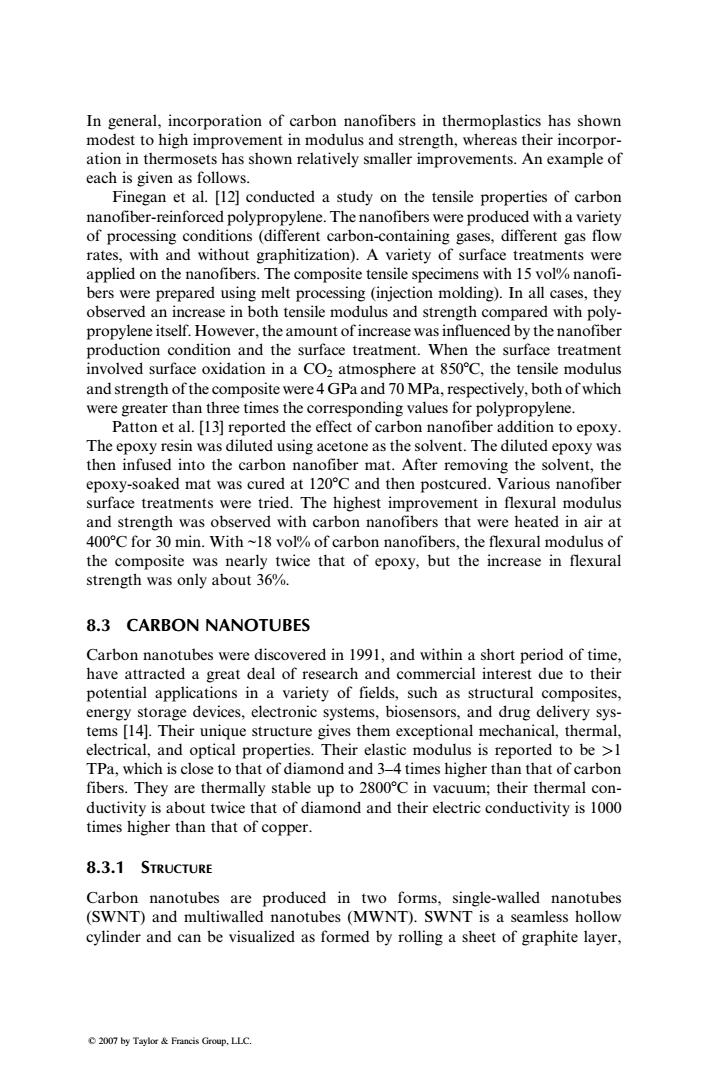正在加载图片...

In general,incorporation of carbon nanofibers in thermoplastics has shown modest to high improvement in modulus and strength,whereas their incorpor- ation in thermosets has shown relatively smaller improvements.An example of each is given as follows. Finegan et al.[12]conducted a study on the tensile properties of carbon nanofiber-reinforced polypropylene.The nanofibers were produced with a variety of processing conditions (different carbon-containing gases,different gas flow rates,with and without graphitization).A variety of surface treatments were applied on the nanofibers.The composite tensile specimens with 15 vol%nanofi- bers were prepared using melt processing (injection molding).In all cases,they observed an increase in both tensile modulus and strength compared with poly- propylene itself.However,the amount of increase was influenced by the nanofiber production condition and the surface treatment.When the surface treatment involved surface oxidation in a CO2 atmosphere at 850C,the tensile modulus and strength of the composite were 4 GPa and 70 MPa,respectively,both of which were greater than three times the corresponding values for polypropylene. Patton et al.[13]reported the effect of carbon nanofiber addition to epoxy. The epoxy resin was diluted using acetone as the solvent.The diluted epoxy was then infused into the carbon nanofiber mat.After removing the solvent,the epoxy-soaked mat was cured at 120C and then postcured.Various nanofiber surface treatments were tried.The highest improvement in flexural modulus and strength was observed with carbon nanofibers that were heated in air at 400C for 30 min.With~18 vol%of carbon nanofibers,the flexural modulus of the composite was nearly twice that of epoxy,but the increase in flexural strength was only about 36%. 8.3 CARBON NANOTUBES Carbon nanotubes were discovered in 1991,and within a short period of time, have attracted a great deal of research and commercial interest due to their potential applications in a variety of fields,such as structural composites, energy storage devices,electronic systems,biosensors,and drug delivery sys- tems [14].Their unique structure gives them exceptional mechanical,thermal, electrical,and optical properties.Their elastic modulus is reported to be >1 TPa,which is close to that of diamond and 3-4 times higher than that of carbon fibers.They are thermally stable up to 2800C in vacuum;their thermal con- ductivity is about twice that of diamond and their electric conductivity is 1000 times higher than that of copper. 8.3.1 STRUCTURE Carbon nanotubes are produced in two forms,single-walled nanotubes (SWNT)and multiwalled nanotubes (MWNT).SWNT is a seamless hollow cylinder and can be visualized as formed by rolling a sheet of graphite layer, 2007 by Taylor Francis Group,LLC.In general, incorporation of carbon nanofibers in thermoplastics has shown modest to high improvement in modulus and strength, whereas their incorporation in thermosets has shown relatively smaller improvements. An example of each is given as follows. Finegan et al. [12] conducted a study on the tensile properties of carbon nanofiber-reinforced polypropylene. The nanofibers were produced with a variety of processing conditions (different carbon-containing gases, different gas flow rates, with and without graphitization). A variety of surface treatments were applied on the nanofibers. The composite tensile specimens with 15 vol% nanofibers were prepared using melt processing (injection molding). In all cases, they observed an increase in both tensile modulus and strength compared with polypropylene itself. However, the amount of increase was influenced by the nanofiber production condition and the surface treatment. When the surface treatment involved surface oxidation in a CO2 atmosphere at 8508C, the tensile modulus and strength of the composite were 4 GPa and 70 MPa, respectively, both of which were greater than three times the corresponding values for polypropylene. Patton et al. [13] reported the effect of carbon nanofiber addition to epoxy. The epoxy resin was diluted using acetone as the solvent. The diluted epoxy was then infused into the carbon nanofiber mat. After removing the solvent, the epoxy-soaked mat was cured at 1208C and then postcured. Various nanofiber surface treatments were tried. The highest improvement in flexural modulus and strength was observed with carbon nanofibers that were heated in air at 4008C for 30 min. With ~18 vol% of carbon nanofibers, the flexural modulus of the composite was nearly twice that of epoxy, but the increase in flexural strength was only about 36%. 8.3 CARBON NANOTUBES Carbon nanotubes were discovered in 1991, and within a short period of time, have attracted a great deal of research and commercial interest due to their potential applications in a variety of fields, such as structural composites, energy storage devices, electronic systems, biosensors, and drug delivery systems [14]. Their unique structure gives them exceptional mechanical, thermal, electrical, and optical properties. Their elastic modulus is reported to be >1 TPa, which is close to that of diamond and 3–4 times higher than that of carbon fibers. They are thermally stable up to 28008C in vacuum; their thermal conductivity is about twice that of diamond and their electric conductivity is 1000 times higher than that of copper. 8.3.1 STRUCTURE Carbon nanotubes are produced in two forms, single-walled nanotubes (SWNT) and multiwalled nanotubes (MWNT). SWNT is a seamless hollow cylinder and can be visualized as formed by rolling a sheet of graphite layer, 2007 by Taylor & Francis Group, LLC